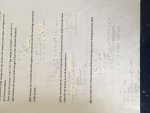miaellenaylee
New member
- Joined
- Jan 11, 2019
- Messages
- 7
Hi,
I required some help with the question below. I was quite stumped when i reached this part of the question. I'm not sure sure where to start.
QUESTION: Two horizontal parallel metal plates are separated by 5cm have a voltage of 2.56V applied between them so that the upper plate is positively charged. A proton is fired horizontally into the space between the plates, just below the upper plate. Assume the plates are large enough that the proton will remain in . the space and ignore any gravitational effects.
Data: mass of proton = 1.67 x 10^-27 kg
Charge of proton = 1.60 x 10^-19 C
e) Identify the horizontal velocity of the proton at prior to hitting the lower plate.
Data I have found from the other sections of the question:
Electric Field Strength: 51.2 NC^-1
acceleration: 4.91 x 10^9 m/s^2 down
time to reach lower plate: 4.52 x 10^-6 sec or 4.52µs
Vertical velocity: 2.21 x 10^4 m/s
All I know is a=0 in the horizontal.
I required some help with the question below. I was quite stumped when i reached this part of the question. I'm not sure sure where to start.
QUESTION: Two horizontal parallel metal plates are separated by 5cm have a voltage of 2.56V applied between them so that the upper plate is positively charged. A proton is fired horizontally into the space between the plates, just below the upper plate. Assume the plates are large enough that the proton will remain in . the space and ignore any gravitational effects.
Data: mass of proton = 1.67 x 10^-27 kg
Charge of proton = 1.60 x 10^-19 C
e) Identify the horizontal velocity of the proton at prior to hitting the lower plate.
Data I have found from the other sections of the question:
Electric Field Strength: 51.2 NC^-1
acceleration: 4.91 x 10^9 m/s^2 down
time to reach lower plate: 4.52 x 10^-6 sec or 4.52µs
Vertical velocity: 2.21 x 10^4 m/s
All I know is a=0 in the horizontal.
Last edited by a moderator:


